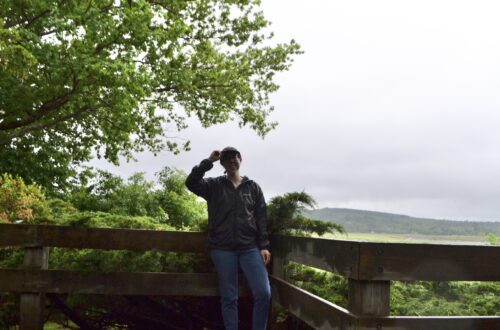
The History of Margaretsville, Nova Scotia
Annapolis County, est. 212 residents
Margaretsville, Nova Scotia, is a rural community that boasts stunning views of the Bay of Fundy shore. Before Dr. John Halliburton was granted the land in the 1780s, the Annapolis Valley region was inhabited by the Mi’kmaq, who lived peacefully off the land until settlers arrived.
Halliburton was a Loyalist refugee from Rhode Island and was granted land in the Wilmot Township area of the province. Originally from Scotland, Halliburton had moved to the United States after serving as a surgeon aboard a British frigate during the Seven Years’ War. He settled in Newport in 1776, where he worked as a British spy before circumstances forced him and his family to make the dangerous journey from New York to Halifax. There, he was granted land in the Margaretsville area for his loyalty to the British from the British Commander-in-Chief for North America, General Clinton.
While Margaretsville is the name we know the area by today, at one point, the region was called Reagh’s Cove, and also Peter’s Point, named after the first settler of the village, Peter Barnes. Barnes grew vegetables in his clearing and fished for a living, but in 1797, an early frost ruined his garden, and fish failed to make their annual run along the coast. Christmas Eve came that year with a wild storm, which caused a small schooner to capsize and its three remaining passengers to end up washed ashore. Their bodies were found the next day, completely void of any jewellery or possessions, with Barnes’ small shelter nearby.
The legend goes that Barnes and his wife had heard the screams of distress, and Barnes went out at his wife’s request to offer aid and shelter. When he returned after a long while, he said that they had both been mistaken about the sounds they had heard. Many accused Barnes of stealing the injured’s possessions and leaving them to die, and the community mainly shunned him for the remainder of his life.
Later, John Halliburton’s son, the Honourable Brenton Halliburton, also received a land grant in the same township after marrying Margaret Inglis, the daughter of Charles Inglis, the first Anglican Bishop of Nova Scotia. Halliburton would go on to become the eighth Chief Justice of Nova Scotia. The town was renamed to Margaretville (without an “s”) after Halliburton’s wife. After the post office was established in 1856, the region was officially named Margaretsville, which still uses the same spelling today.
During Maragrestville’s heyday, the town featured a hotel, two general stores, a customs office, and a vital shipyard which contributed to its greatest prosperity.
Shipping and Shipbuilding in Margaretsville
As time went on, Margaretsville became a hub for shipping, shipbuilding, and fishing. In the mid-to-late 1800s, Nova Scotia possessed the world’s fourth-largest commercial fleet. The town became a significant port on the Bay of Fundy and a centre for the construction of two- and three-masted sailing ships, including brigantines, barks, and schooners, as well as eventually coastal steamships, as the age of sail transitioned to steam.
The vessels built in Margaretsville ranged in size from small ships of around 50 tons to large two- and three-masted brigs and schooners. One of those ships was the white-hulled Shenandoah, a 198-ton tern schooner, built in 1891 by James Martin. Martin was an immigrant from Ireland, renowned for his skills as a shipbuilder.
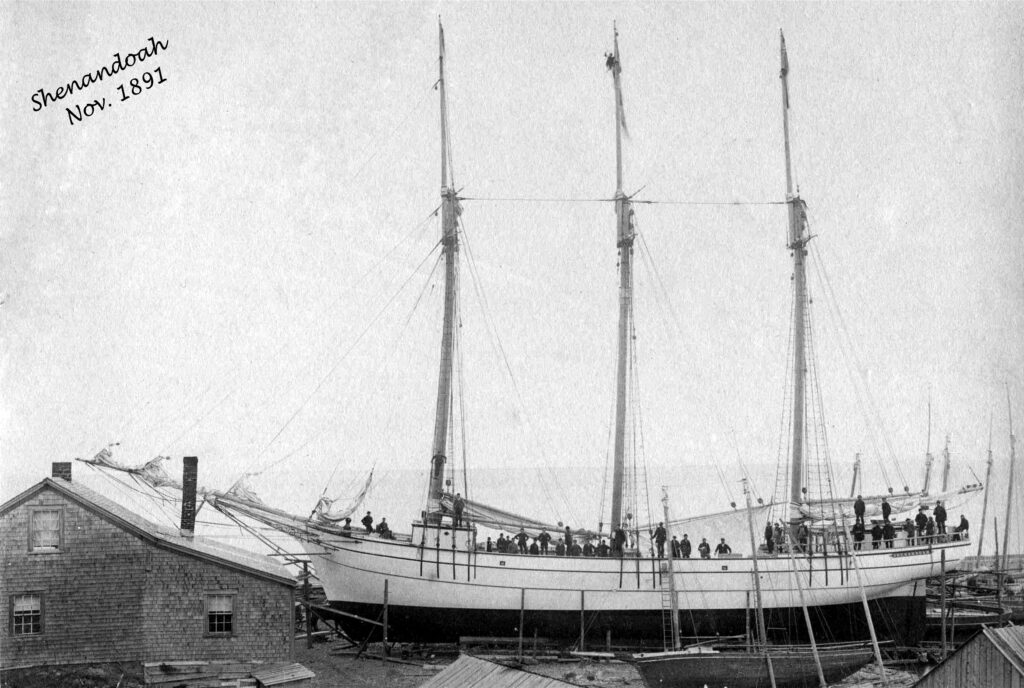
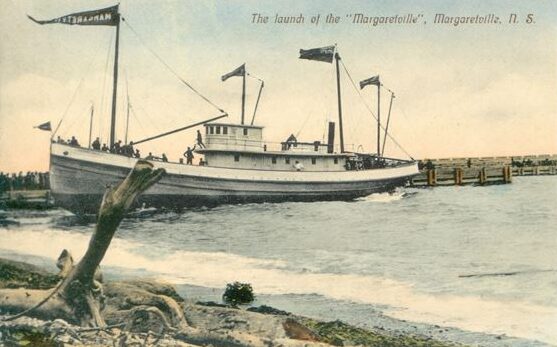

The harbour was vital in shipping local goods from the Annapolis Valley region, such as apples, potatoes, and cordwood, to places like Boston, New York, and the Caribbean. Returning to Margaretsville would be manufactured goods from the United States, flour, and molasses from the Caribbean to produce rum.
An essential part of keeping the harbour clear and safe was the Margaretsville Lighthouse. In 1856, residents of Margaretsville began petitioning for a lighthouse to mark the local pier. At the time, the Committee on Navigation Securities recommended that a beacon light, without a building, be built on the dock instead. It wasn’t until William Condon, Superintendent of the Board of Works, visited Margaretsville in 1858, where he discovered that the proposed plan was “universally dissatisfactory to those interested in the navigation of the Bay,” that he decided not to proceed with it.
Instead, Brenton Halliburton came forward and offered to provide the necessary land for the lighthouse at no cost, allowing the construction of a formal lighthouse to proceed. The lighthouse, built in 1859, was one of the first in Nova Scotia’s Bay of Fundy region. William Early served as the first lighthouse keeper from 1859 to 1887. With a square wooden tower with sloping sides, it was constructed in the typical pepper-shaker style and featured a wide horizontal stripe.
Ruth Earley, keeper from 1907 to 1910, was one of the first women to officially serve as a lighthouse keeper in Nova Scotia. Gordon Aldred was the final keeper of the light, serving from 1956 to 1963, when electricity replaced the oil lamp and the light became fully automated. By this point, there was little activity remaining at the warf in Margaretsville, but it still serves fishing vessels and recreational boaters to this day.
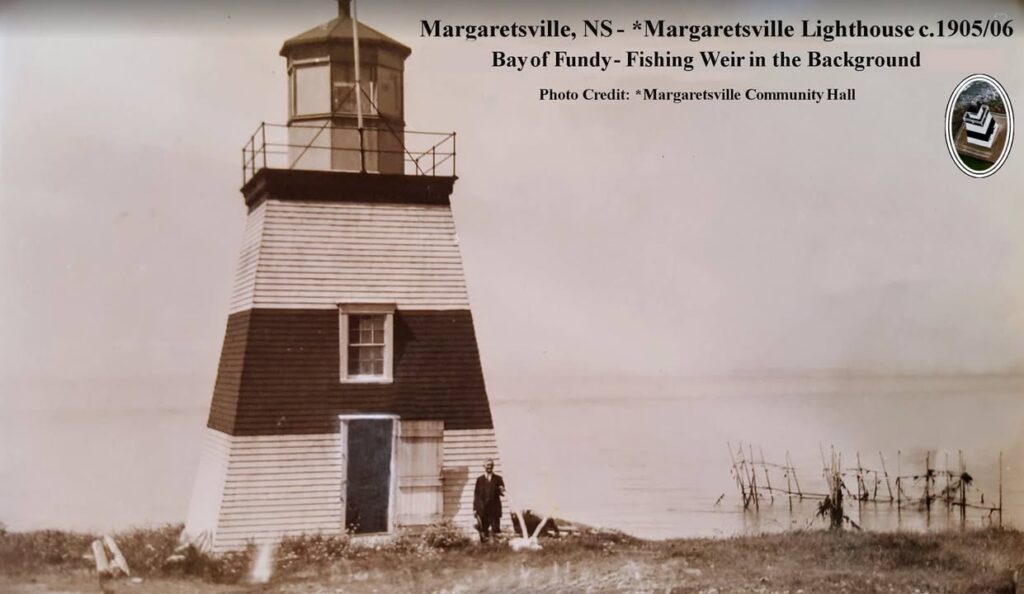

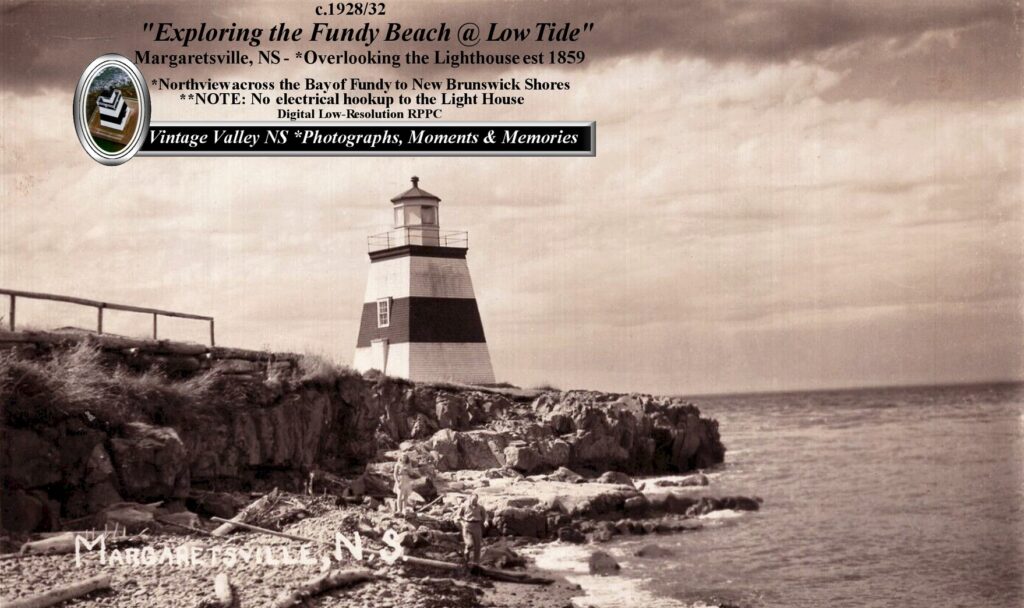
The Friends of Margaretsville Lighthouse Society was formed in 2013 to gain ownership of the lighthouse for the community. Although they did not place in a 2015 crowdfunding competition sponsored by the National Trust for Canada and the Nova Scotia Lighthouse Preservation Society, the society earned $1,780 in the fundraising portion of the competition. As of 2018, the society obtained a lease on the lighthouse from the Department of Fisheries and Oceans.
Fishing was another industry prominent in Margaretsville that grew over time. In 1838, the census for the Margaretsville region didn’t list a single fisherman, but by 1871, six men had that occupation recorded. These included Jeremiah Cropley, Samuel Lunn, John Gordon, Gilbert Baker, Henry Fales, and Richard Aldred. The fish most often caught in the Bay of Fundy were herring, haddock, halibut, hake, pollack, and cod. The lobster industry also accounted for a significant share of the fishery catch, a trend that continues to this day.
Several factors have contributed to the decline of Margaretsville’s fishing industry, including the loss of the big wharf, the general decline in fish stocks, falling market prices, and rising operational expenses. Today, fishermen have become accustomed to fishing on a small scale, catching enough to meet local demand.
Margaretsville Today
The Margaretsville Boathouse Heritage Centre and Boardwalk is a community-run museum that offers visitors an opportunity to explore the history of Margaretsville’s shipbuilding and fishing industries through various exhibits. The centre is situated within a shoreline park and is housed in a historic boathouse built around 100 years ago.



The Margaretsville Art Shack Gallery showcases exceptional artwork created by local artists in a building that was formerly a fish shack near the town’s wharf. The Artist’s Circle is a registered cooperative of artists residing or working in the Annapolis Valley region. During the summer months, the gallery welcomes active members who wish to display and sell their artwork along the shores of the Bay of Fundy.
Margaretsville is a beautiful village with timeless charm. Whether you’re watching the Bay of Fundy tides roll in, exploring the rocky cliffs, or enjoying the community’s creative spirit, Margaretsville reminds visitors that the best stories are often found in small, quiet places that have stood the test of time.
A big thank you to the Vintage Valley NS *Photographs, Moments & Memories for the photos provided on Facebook, as well as Dave Murray from the Margaretsville Shore Society for more information about the area.



